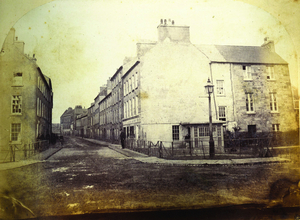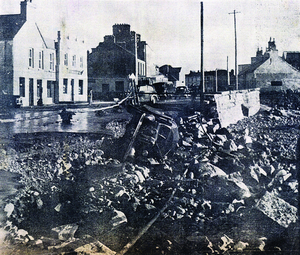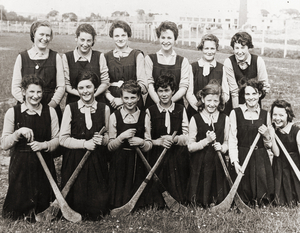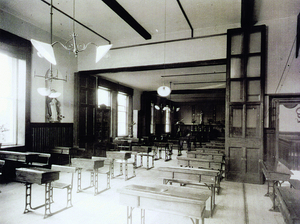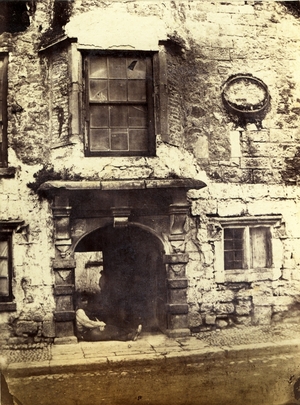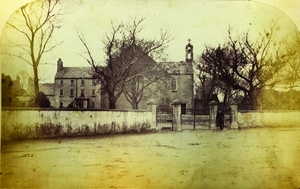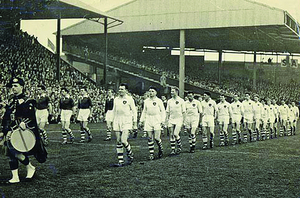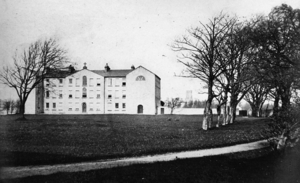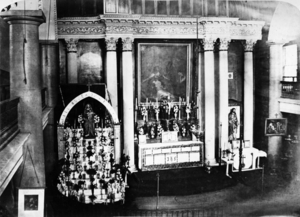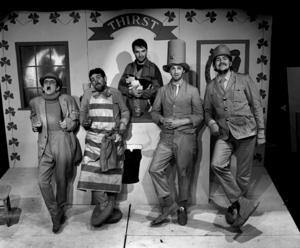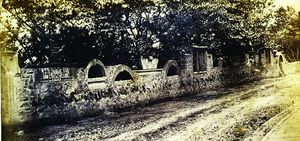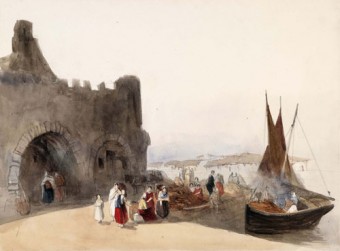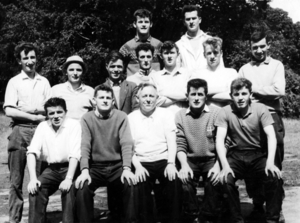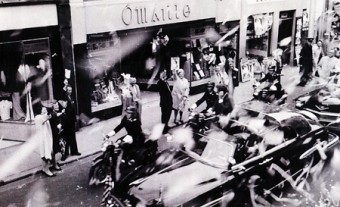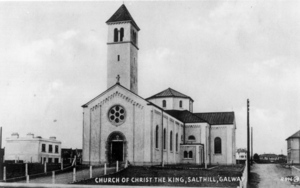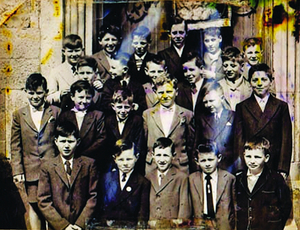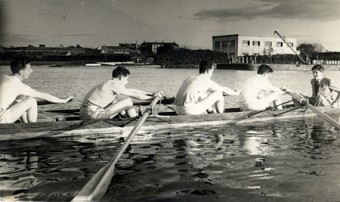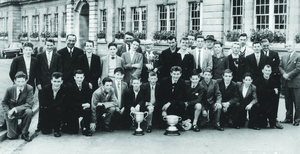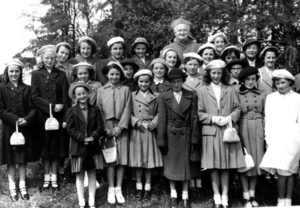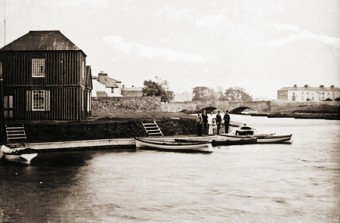Lower Dominick Street about one hundred and fifty years ago
Thu, Sep 26, 2013
According to Hely Dutton, Dominick Street was built in the early part of the 19th century. It was outside the old city walls and was an indicator of how Galway was beginning to expand at the time. This photograph, which was taken c1965, is probably the earliest existing image of the street.
Read more ...Hurricane Debbie
Thu, Sep 19, 2013
On the morning of September 16 1961, gale warnings were issued because of a possible impending storm. Violent storms are almost never actual hurricanes by the time they reach Ireland, but all of that was about to change that morning. Hurricane Debbie was the only hurricane, that is known about, to have made landfall in Ireland as a Category 1 event. Gusts of more than 180 kilometres an hour were recorded, and while the winds were not as strong as the gusts, they were capable of causing a lot of damage. Eighteen people died in Ireland as a result of the storm, six in the North and 12 in the South. They were killed by collapsing walls and trees, one was drowned from a small boat, and a young boy was blown into a stream. Tens of thousands of houses and other structures were damaged, some were completely destroyed, some suffered roof loss, while others had lesser damage such as windows blown in, etc.
Read more ...Galway camogie
Thu, Sep 12, 2013
We know from the old sliotars on exhibition in the folk museum in Turlough near Castlebar that the game of hurling has been played for many centuries, but what of the game of camogie? Two prominent Irish language enthusiasts and cultural nationalists, Máire Ní Chinnéide and Cáit Ni Dhonchadha, were credited with having created the sport while a brother of Cáit, Tadg, was the person who drew up the rules in 1903. So there was always a male presence within the administrative ranks of the sport. The game emanated from the Gaelic League and was dependent on the structures and networks provided by that organisation during the initial expansion of the sport. It was also closely linked with the GAA.
Read more ...The Dominican school at Taylor’s Hill
Thu, Sep 05, 2013
As the Penal Laws began to relax at the beginning of the 19th century and conditions became a little more lenient for Catholic religious orders, some of them began to think of a return to community life. The Dominican Nuns, whose community had flourished during Penal times, was now reduced to six. There was a lot of building going on in the area of their nunnery in Cross Street, and houses closed in their convent on all sides, making a life of strict enclosure very difficult. The sisters began to search for another house, more secluded, where they could follow their Rule, free from distraction.
Read more ...De Burgo’s mansion
Thu, Aug 29, 2013
This wonderful photograph, dated c1865, shows a carved stone doorway in Market Street, an interesting example of Renaissance work, almost certainly earlier than the Browne Doorway.
Read more ...The West Chapel
Thu, Aug 22, 2013
One hundred and ninety eight years ago this month (August 4, 1815), the first High Mass was sung in the West Chapel, and about 50 years later this photograph was taken of the exterior of the building. It was the third church the Dominicans had in the Claddagh.
Read more ...The 1956 All-Ireland final
Thu, Aug 15, 2013
Galway made it to the All-Ireland final in 1956 for the first time since 1942. They beat Mayo, Roscommon, Sligo, and Tyrone on the way and faced Cork in the final. The match was delayed for three weeks because of an outbreak of polio in Cork. It was played on October 7 in front of more than 70,000 people and it turned out to be one of the most exciting and thrilling finals in the history of the sport.
Read more ...‘A powerhouse of prayer’
Thu, Aug 08, 2013
The exact origins of the Poor Clare Sisters in Galway are not easy to trace. We know there was a convent of Clares, if not Poor Clares, here before 1640, based on an inscription on a headstone which read “Here lieth the body of Elizabeth Lynch, the Foundress of the Order of St. Clare who died 14th December 1626”. James Hardiman describes another headstone inscribed thus: “Here lieth the body of R. Mother Maria Gabriel, alias Helen Martin, first Abbess and religious of the Poor Clares of Galway who died on 14 January aged 68 in religion for 40. Pray for her Soul.” This suggests the nuns were in Galway since 1632 when she entered the order.
Read more ...The pro-cathedral, a brief history
Thu, Aug 01, 2013
“On Monday last (July 1st, 1816), Galway witnessed a scene unparalleled in her history, or in the history of the British Empire. It was an unusual but gratifying sight to behold Protestants and Catholics, the Civil and Ecclesiastical Corporations, the Secular and Regular Clergy, all clothed in their robes of office, preceded by their various insignias, and marching in solemn procession through the principal streets of the town – not for the purpose of reminding Catholic of the galling degradation under which he labours – not to keep alive those feuds which have so long distracted our wretched country – not to display with ascendancy, pride and intolerant bigotry, those shameful destructions which have hitherto been a barrier to the repose and happiness of Ireland – no – but to lay the foundation stone of an edifice, which being dedicated to the supreme worship of the deity, will at the same time be a monument to succeeding generations of the unanimity, concord and harmony which exists between those of every religious persuasion in this loyal and extensive county.
Read more ...Druid Theatre Company, the early years
Thu, Jul 25, 2013
For many years theatre in Galway was represented by regular productions from An Taibhdhearc and occasional productions by the Dramatic Society in UCG. Occasionally, other groups appeared but they never seemed to survive for very long — The Lamplighters, The D And I, The Galway Little Theatre Company, etc. Most of these were enthusiastic amateurs who often put on memorable shows. In 1969 an attempt was made to introduce semi-professional theatre to the city with the formation of The Galway Repertory Theatre, and two years later Frank Bailey founded the Celtic Arts Theatre, but sadly, both of these companies were short lived.
Read more ...Newtownsmith c1870
Thu, Jul 18, 2013
Newtownsmith was an important development outside the town wall on the northern side of the city in the late 18th and early 19th century. The project was undertaken by the governors of the Erasmus Smith Estate. In this suburb, the county courthouse was erected between 1812 and 1815, and a little later in 1824 the town courthouse was built. In 1823, it was objected to because there were several suitable sites for a new courthouse ‘immediately in the town’ and that it was ‘quite idle’ to lay foundations in Newtownsmith, or in any part of the suburb. Galway’s second bridge was completed in 1819 and it connected the courthouses with the new county and town gaols on Nuns Island which had been completed in 1810.
Read more ...William Evans of Eton and his old Galway watercolours
Thu, Jul 11, 2013
William Evans of Eton (1798-1877) was the drawing master of Eton College in England and was an accomplished artist who exhibited widely in London, Dublin, and Paris. He made a number of visits to the west of Ireland in 1835 and 1838 where he produced many studies and finished watercolours, mostly of Counties Galway and Mayo, a mixture of picturesque landscapes, market and street scenes, and what might be called peasant structures and peasant portraits.
Read more ...Our Lady’s Boys Club, a brief history
Thu, Jul 04, 2013
When OLBC was founded in 1940, the Government provided no out of school education for young people. There was a great need for social and recreational facilities. Such activity was virtually non-existent in the working class areas of Bohermore, Shantalla, The Claddagh, and ‘The West’. The critical core of the club was (and is) its generic youth club which met (and still meets) several evenings a week. The primary aim in those days was to show the boys ways and means of securing their own destiny.
Read more ...An hour to remember
Thu, Jun 27, 2013
It is hard to believe that president John F Kennedy’s visit to Galway only lasted one hour. It was timed with military precision and yet JFK seemed remarkably relaxed and enjoying himself thoroughly throughout. He landed by helicopter in the Sportsground where he was met by the mayor, Paddy Ryan, a group of schoolgirls from the Mercy National School all dressed in green white and gold, some members of the American legion, and a crowd of enthusiastic onlookers.
Read more ...Salthill Church, a brief history
Thu, Jun 20, 2013
A meeting of the residents of the Salthill area was held in the Pavilion Ballroom in June 1934 for the purposes of considering the necessity of erecting a church in Salthill. They unanimously expressed the urgency of building one to cater for the religious needs of about 300 families representing approximately 400 residents and a large number of summer visitors. At that time there were about 200 families from the Bishop’s Gate to Rockbarton and there was provision made for the building of close on 100 houses.
Read more ...The Claddagh National School
Thu, Jun 13, 2013
An advertisement in the Irish Independent in July 1931 invited tenders from competent builders for the erection and completion of the proposed new St Nicholas’ National School in the Claddagh. When the new school was built it was described as “An attractive rectangular building with a red tile roof made by the Galway Brick and Tile Company”. The outdoor toilets were at the end of the playground.
Read more ...Where there’s a will, there’s a way
Thu, Jun 06, 2013
Now that the Leaving Certificate exams are about to start and the rowing season is in full swing, we thought to share the following story.
Read more ...In their green and black jerseys...
Thu, May 30, 2013
Victory in the 1961 County Juvenile Hurling final for the Father Tom Burke’s team from the Claddagh in the same colours their grandfathers wore in the great days of hurling in South Park recalled memories of the Moores, the Macs, the Currans, and the Carricks.
Read more ...Calling Castlegar people
Thu, May 23, 2013
A report from the Educational Commission in Ireland in 1826 lists two hedge schools in the parish of Castlegar. The first of these was at Merlin Park, built by the landlord Mr Blake. The 40 boys and 20 girls who attended got free tuition. The second school was at Ballygurrane, a few hundred yards north of where Scoil Colmcille Naofa stands today. It was a thatched house which doubled as a church on Sundays. Each pupil paid one shilling and eight pence per quarter. There were 30 boys and 15 girls on the rolls. The thatched house was accidentally burnt down in 1827, and the school transferred to a stable in the village of Castlegar. Here, without desks or books, the teacher named Duggan from Bohermore taught his pupils as they sat around on stones as seats. Each morning he rode out on his donkey from Bohermore. His salary depended on the few pence he got from his students. He taught the three Rs through the medium of English.
Read more ...The Royal Galway Yacht Club
Thu, May 16, 2013
The first rowing club to be set up on the river was Corrib Rowing and Yachting Club, and shortly afterwards the Commercial Club was founded. The inauguration of yet another club in 1882, The Royal Galway Yacht Club, provided further competition in rowing and yachting. It contributed to regattas locally by fielding crews, being included on committees, and other rowing activities, and it seems to have had a very strong yachting section.
Read more ...